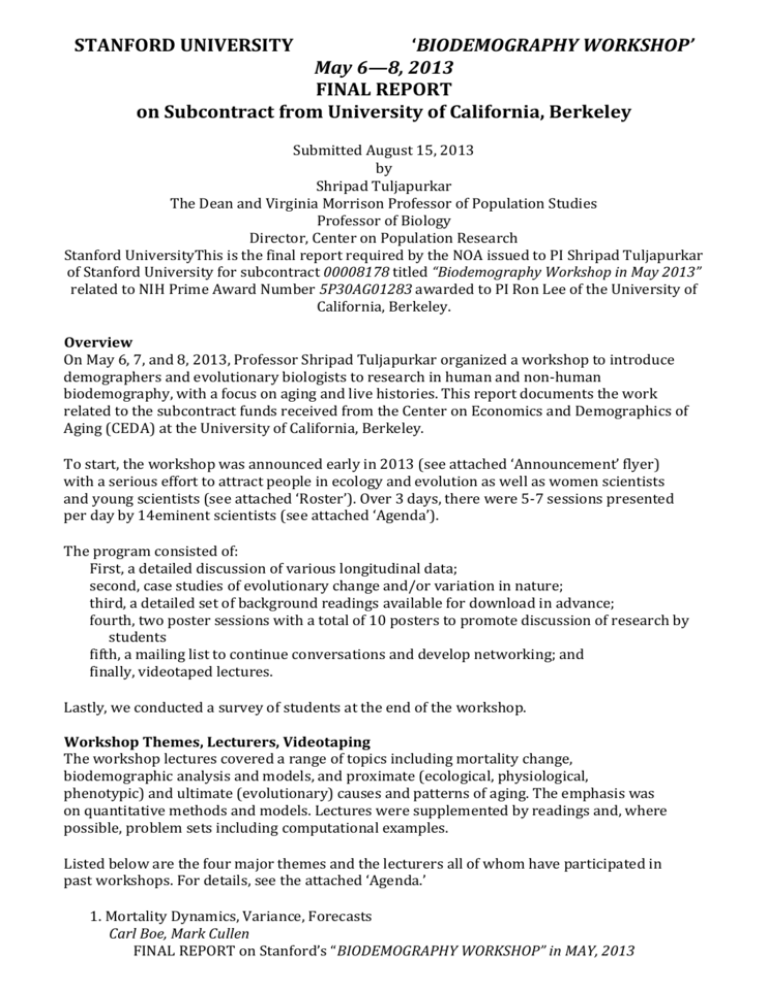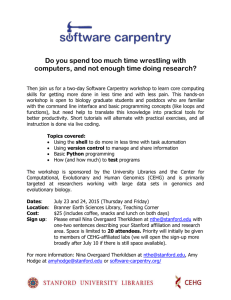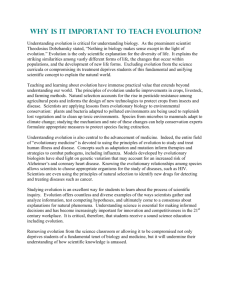Final Report - Center on the Economics and Demography of Aging
advertisement

STANFORD UNIVERSITY ‘BIODEMOGRAPHY WORKSHOP’ May 6—8, 2013 FINAL REPORT on Subcontract from University of California, Berkeley Submitted August 15, 2013 by Shripad Tuljapurkar The Dean and Virginia Morrison Professor of Population Studies Professor of Biology Director, Center on Population Research Stanford UniversityThis is the final report required by the NOA issued to PI Shripad Tuljapurkar of Stanford University for subcontract 00008178 titled “Biodemography Workshop in May 2013” related to NIH Prime Award Number 5P30AG01283 awarded to PI Ron Lee of the University of California, Berkeley. Overview On May 6, 7, and 8, 2013, Professor Shripad Tuljapurkar organized a workshop to introduce demographers and evolutionary biologists to research in human and non-human biodemography, with a focus on aging and live histories. This report documents the work related to the subcontract funds received from the Center on Economics and Demographics of Aging (CEDA) at the University of California, Berkeley. To start, the workshop was announced early in 2013 (see attached ‘Announcement’ flyer) with a serious effort to attract people in ecology and evolution as well as women scientists and young scientists (see attached ‘Roster’). Over 3 days, there were 5-7 sessions presented per day by 14eminent scientists (see attached ‘Agenda’). The program consisted of: First, a detailed discussion of various longitudinal data; second, case studies of evolutionary change and/or variation in nature; third, a detailed set of background readings available for download in advance; fourth, two poster sessions with a total of 10 posters to promote discussion of research by students fifth, a mailing list to continue conversations and develop networking; and finally, videotaped lectures. Lastly, we conducted a survey of students at the end of the workshop. Workshop Themes, Lecturers, Videotaping The workshop lectures covered a range of topics including mortality change, biodemographic analysis and models, and proximate (ecological, physiological, phenotypic) and ultimate (evolutionary) causes and patterns of aging. The emphasis was on quantitative methods and models. Lectures were supplemented by readings and, where possible, problem sets including computational examples. Listed below are the four major themes and the lecturers all of whom have participated in past workshops. For details, see the attached ‘Agenda.’ 1. Mortality Dynamics, Variance, Forecasts Carl Boe, Mark Cullen FINAL REPORT on Stanford’s “BIODEMOGRAPHY WORKSHOP” in MAY, 2013 2. Gene Expression: GWAS, SNPS, BLUPS, EWAS David Rehkopf, David Steinsaltz, Ken Wachter, Anatoli Yashin 3. Quantitative Trait Dynamics and Genotypic Variation: Natural and Lab Populations andHuman Longitudinal Studies Dylan Childs, James Holland Jones, Patrick Phillips, Uli Steiner, Shripad Tuljapurkar 4. Evolutionary Data and Theory: Animals, Plants, and Humans Hal Caswell, Carol Horvitz, Ron Lee, C. Jessica Metcalf Most of the presentations were videotaped using Camtasia software and will be made available to the attendees via the web once final editing is complete. Participants, Poster Sessions, Survey We advertised beginning in February 2013 to an extensive mailing list (population programs, graduate programs) and posted announcements at PAA and elsewhere aiming at graduate students, postdocs and young faculty in two areas --demography/biodemography and ecology/evolution -with special emphasis on participation by women scientists and by young scientists. Applicants were asked to provide a 1-paragraph statement of why they wished to attend and a 1-page CV, and if they applied for support, a supporting letter from a faculty member. We provided support for local transportation, breakfast and lunch at the meetings, and travel and lodging (shared rooms). We received 32 applications and admitted 29 participants: 14 are graduate students with strong representation from the major population studies programs around the US; 8 are postdocs; and the remainder are young faculty and foreign applicants. Of the 29, 17 are women. Some participants received partial support and some paid their own costs (many of these are Stanford and Berkeley students). More detail is available on the attached ‘Roster.’ A poster session each of the first two days was offered in order to showcase the research of 10participants. Applicants who wished to participate submitted an abstract. The ten spots filled quickly and a short waiting list was developed. See attached ‘Poster Sessions’ for titles. Faculty engaged in these sessions to offer feedback, to generate cross-talk, and to promote networks. We conducted a survey at workshop-end which provided useful feedback (see attached ‘Questionnaire – Form and Results’) and will be used in planning the next workshop. As can be seen from the information contained in this report, the workshop met its stated aims which were: 1 to introduce demographers and evolutionary biologists to research in human and nonhuman biodemography, with a focus on aging and life histories; 2 to introduce concepts, quantitative formulations and data analytic approaches to genetic studies of human and natural populations; 3 to acquaint students with current research questions, directions, and contributions in biodemography; and 4 to promote crosstalk and networks among young and established researchers with a wide range of backgrounds.





